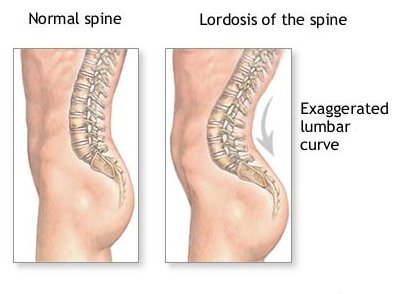What is Lordosis?
Lordosis is defined as an excessive inward curve of the spine. It differs from the spine’s normal curves at the cervical, thoracic, and lumbar regions, which are, to a degree, either kyphotic (near the neck) or lordotic (closer to the low back). The spine’s natural curves position the head over the pelvis and work as shock absorbers to distribute mechanical stress during movement.
Lordosis is found in all age groups. It primarily affects the lumbar spine, but can occur in the neck (cervical). When found in the lumbar spine, the patient may appear swayback, with the buttocks more prominent, and in general an exaggerated posture. Lumbar lordosis can be painful, too, sometimes affecting movement.
Contributing Factors
Certain disease processes can adversely affect the structural integrity of the spine and contribute to lordosis. Some common causes include discitis, kyphosis, obesity, osteoporosis, and spondylolisthesis.
*Discitis is inflammation of intervertebral disc space.
*Kyphosis (eg ‘humpback’) may force the low back to compensate for the imbalance created by a curve occurring at a higher level of the spine.
*Obesity may cause some overweight people to lean backward to improve balance. This has a negative impact on posture.
*Osteoporosis is a bone density disease that may cause vertebrae to loose strength, compromising the spine’s structural integrity.
*Spondylolisthesis occurs when one vertebra slips forward in relation an adjacent one, usually in the lumbar spine.
Tight lower back muscles may also be a contributing factor.
Not every lordosis requires medical treatment. However, when the curve is rigid (fixed), medical evaluation is warranted
Lordosis symptoms
Symptoms of this abnormality depend upon the severity of the disease. Lordosis symptoms may include:
- C-shape back when seen from a lateral aspect, with the buttocks being more prominent
- A large gap between the lower back and the floor when lying on one’s back
- Pain and discomfort in the lower back
- Problems in moving in certain ways
Treatment for Lordosis
- If the lordosis is mild, then treatment is usually not required.
- If the patient is experiencing symptoms or discomfort, then the patient can enroll in a physical theraphy program where exercises can be done, under the guidance of a therapist, in order to strengthen the muscles and to increase the range of motion.
- Medications such as NSAID’s or pain killers can be used to decrease pain or swelling if any.
Shockwave therapy will help loosen the tight back muscles that are working overtime to keep posture upright. Thus may help decrease some of the force that is going through the hips and lumber region.




